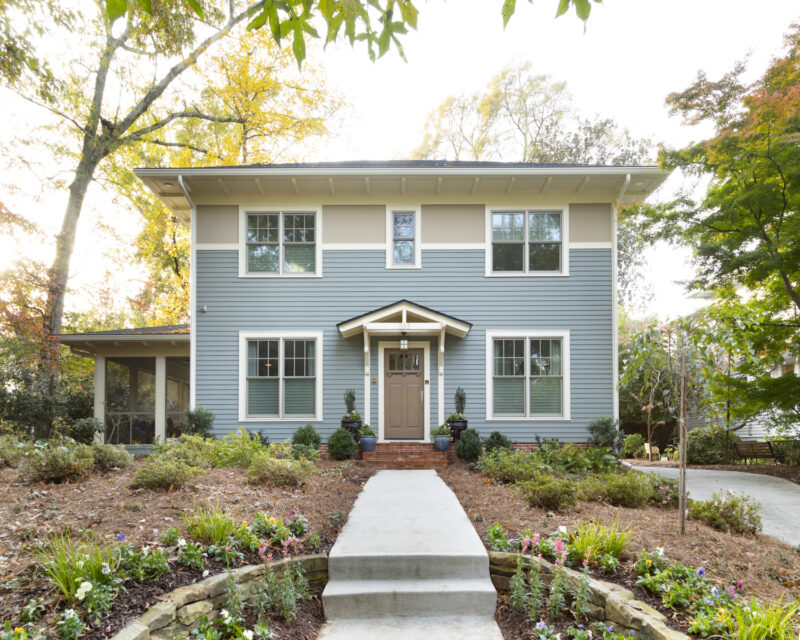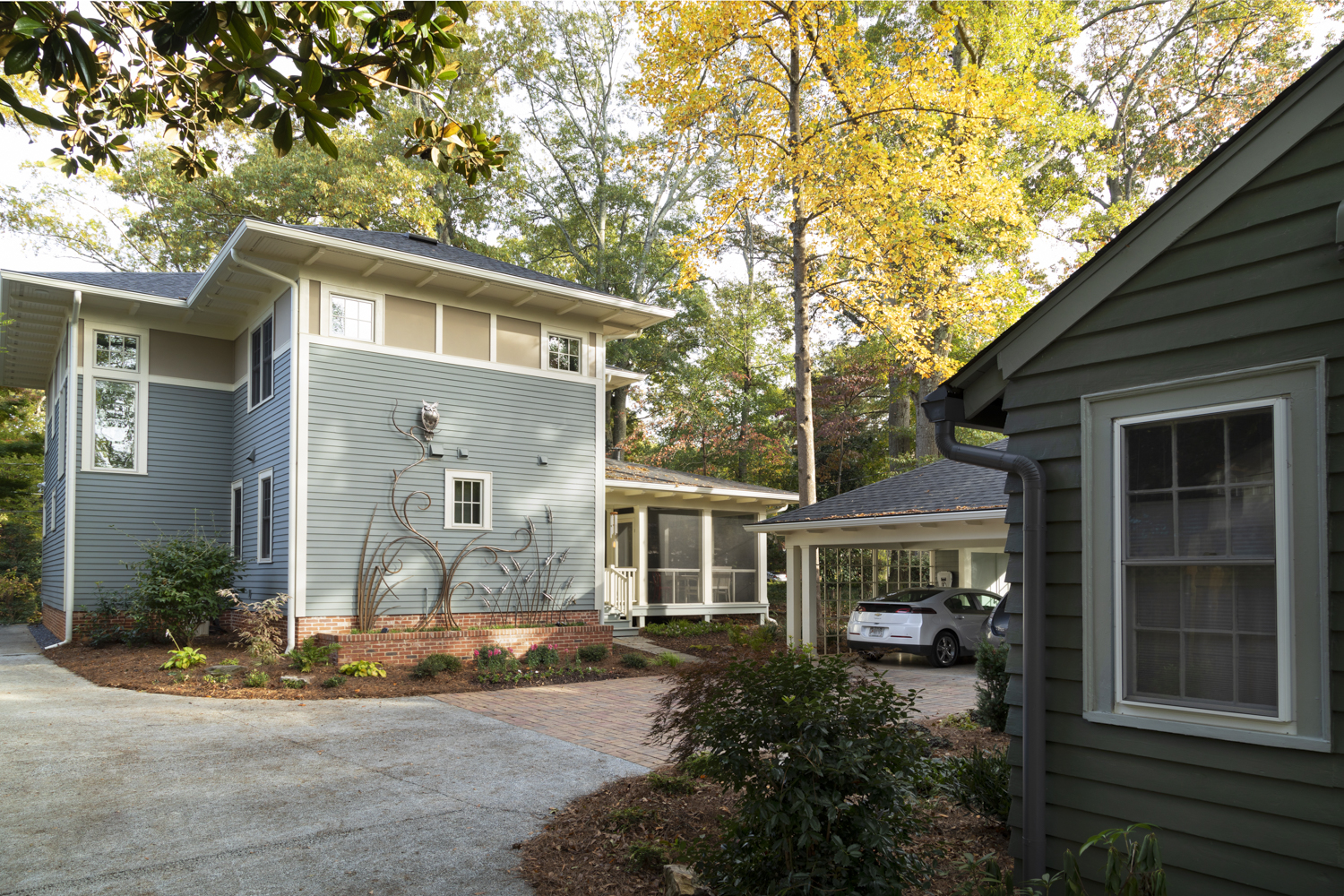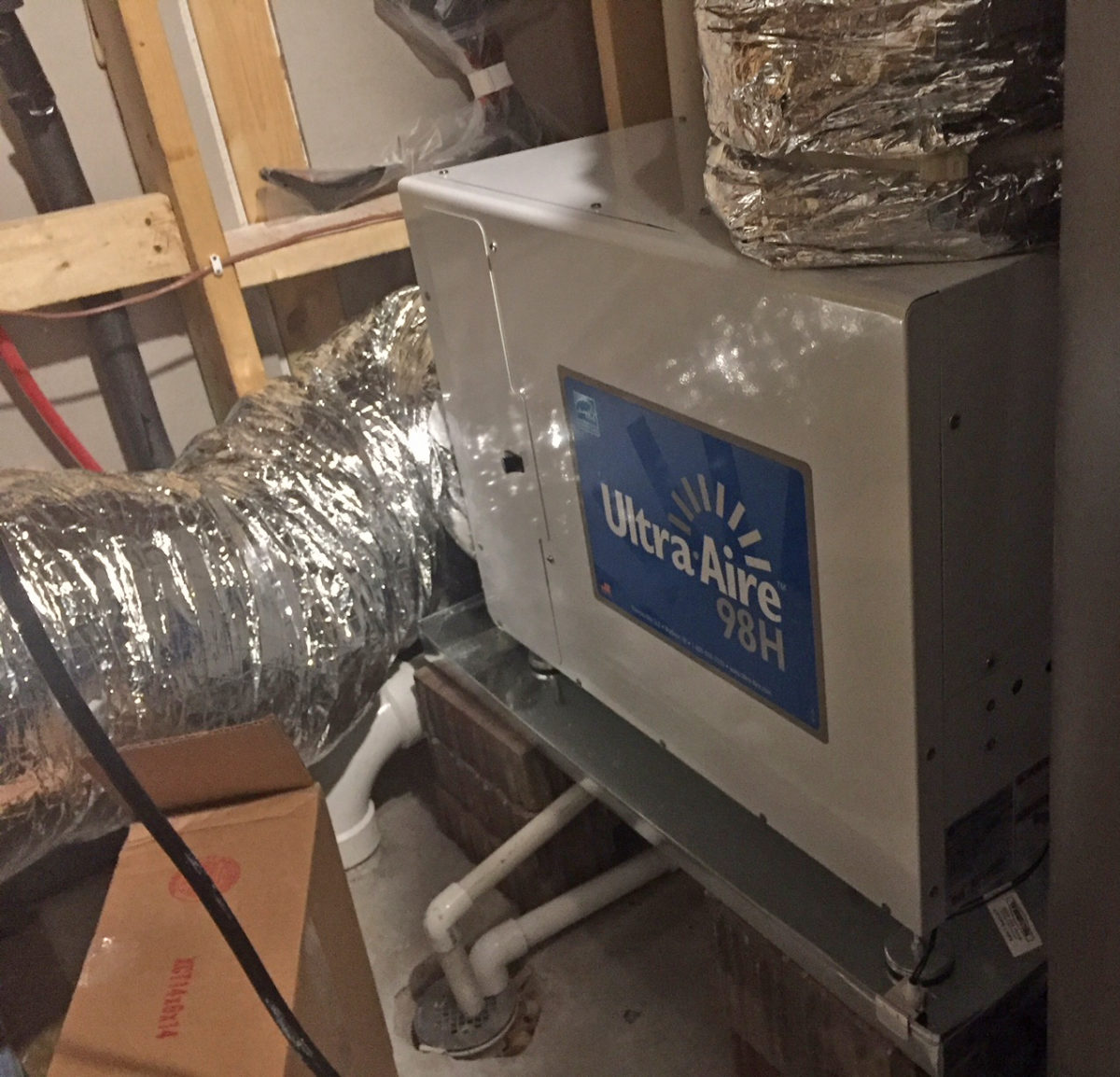
07 Oct High-Performance Building in a Humid Climate
A new home in the Southeast demonstrates effective strategies for controlling moisture, creating efficiencies, and ensuring comfort
Article originally posted at Green Building Advisor* (*Must have GBA Prime Membership to access full article).
Most of building science tends to have a cold-climate bias. Although I am originally from New York, I have spent my entire professional life as a contractor and consultant in Georgia. In this mixed-humid climate (Zone 3A), the most critical issue facing builders is moisture. We experience high humidity most of the summer and periodically in spring and fall, and dry weather in the winter. Regular heavy-rain events make designing for bulk water management key. In my new home, I addressed these moisture issues with air sealing, weather barriers and flashing, HVAC design, ventilation, large roof overhangs, and site work.
The science of climate and humidity
The Atlanta area has similar total Heating Degree Days and Cooling Degree Days. We have moderate winters with few days below freezing, and long, humid, but not oppressively hot summers with few days over 90°F. The temperature differential between the interior and exterior is rarely more than 20 degrees in the summer and 40 degrees in the winter, requiring less insulation than is needed in colder climates to maintain comfort.
Humidity control, however, is a significant issue, particularly in our shoulder seasons, when we don’t need heating and cooling. Comprehensive air sealing helps manage moisture by not allowing air—and the moisture in it—to infiltrate into the house during humid weather or exfiltrate out during dry weather, helping to maintain comfortable relative humidity levels. To manage this, I designed my house for the most straightforward air sealing possible.
Designing for moisture and bulk water management
I chose a simple volume (no cantilevers or vaults) on a slab foundation; the wood-framed walls were covered with Zip System sheathing, which made for an excellent air seal with minimal effort. On the top floor, I installed Zip on top of the ceiling joists, and taped at the seams and to the wall sheathing to create a complete air seal. I had seen this detail in some Passive House projects and knew it would provide a quality air seal between the house and the unconditioned attic. I had no need for an insulated roofline, as I did not need any extra storage space, nor was I planning to install any ductwork in the attic—a common practice in this region.
This design also allows for a mechanical chase below the attic insulation and eliminates the need for air sealing around lights, fans, and ducts that would be required in an insulated ceiling. Since I had the attic floor decked, the house was essentially airtight at rough-in, and I was able to do a blower door test prior to insulation or drywall. The result was about 1.5 ACH50. I was able to locate Perennial Wood tongue-and-groove decking, a discontinued acetylated pine material, that enabled me to build a traditional southern porch without fear of the flooring rotting or warping over time.

Exterior view of the main house, carport, and carriage house.
For durability—and to fit into the historic district aesthetic—we installed 36-in.-wide eaves, a vented rainscreen behind composite siding, and aluminum clad simulated divided-lite windows. The wide eaves keep most of the rainwater off the siding, and the vent space behind the siding allows water to drain and walls to dry.
I did not need a basement, and as a crawlspace would have been challenging to keep dry due to the pervious driveway and a limited allowable finished floor height above grade, I decided that a slab foundation was the best option. The slab is raised on a stem wall, insulated at the edge and underneath (24 inches to the inside of the perimeter) to provide the appearance of a crawlspace, which was mandated to meet historic district requirements. Because there is no in-floor radiant heat and the ground temperatures are moderate, there was no need for insulation underneath the entire slab. In fact, slab insulation is generally avoided in warmer climates due to the potential for termite infestations.
Stormwater runoff was managed with a combination of pervious concrete and pervious pavers for the entire driveway, and I installed a large drywell where we piped most of the downspouts to manage roof water. It’s worth noting that although these measures minimize stormwater runoff, the lowest parts of the lot still collect significant amounts of surface water during heavy rains.
HVAC design for minimizing ductwork
Speaking from my experience working with single- and multifamily- home builders, HVAC systems tend to have too much ductwork. High-performance homes don’t have extensive heat loss and gain. This means they can be adequately conditioned without running ducts all the way to the building perimeter—this is particularly true in moderate climates. Having had a good experience with ductless minisplits in my small cottage, I wanted to see how effectively a larger home could be conditioned without extensive ductwork.

Ultra Aire Dehumidifier – ultimately removed due to excessive heat while operating.
The HVAC design included one ductless minisplit on the first floor and two on the second floor—one in the main bedroom and one in the hallway leading to two front bedrooms. I installed a large bath fan near the hallway unit, set to turn on with the mini split, ducting some air into the two bedrooms. Although this does not provide air at the typical temperatures for heating and cooling, it does provide enough conditioning to keep the rooms comfortable (because the building envelope is tight). After living in the house for several months, I installed a dehumidifier to help manage the humidity when it was too cool for air conditioning, but it produced a significant amount of heat when operating. This led to the need for re-cooling, so I ultimately removed it. If I need additional dehumidification, I just turn the thermostat down a few degrees.
Ventilation is critical in tight homes, especially those with excess humidity. Such was my case, as we do not open our windows for most of the summer. I installed an energy recovery ventilator (ERV) to provide balanced ventilation as well as ENERGY STAR bath exhaust fans ducted with short runs of rigid pipe to the exterior without any elbows. A 300 CFM kitchen exhaust fan ducted to the exterior avoids the need for a makeup air system, which is required by code and green building programs for any hoods over 400 CFM to avoid depressurizing the house.
Building efficiencies and occupant comfort
Plumbing included WaterSense fixtures throughout and I provided hot water piping through a site-built manifold system with 1/2-in. lines to each fixture in the most direct route possible to provide hot water to each fixture within 20 seconds or less. I considered using a heat pump water heater, but it would have required me to either duct it to the exterior, which was not a practical option, or to have a louver door on the mechanical closet, which would have made the motor noise more noticeable than I desired. I ended up with a Rheem marathon electric heater.
Lighting is LED throughout. I used a combination of integrated LED fixtures and standard fixtures with LED bulbs. All appliances are ENERGY STAR-rated, where available, including an induction range and a condensing dryer, which does not have a vent to the exterior—a useful option to avoid depressurization in a tight house.
Window orientation can be a major comfort and energy efficiency factor in a climate with large cooling loads. East-, west-, and south-facing windows can allow significant solar gain. South-facing windows can be shaded with overhangs, but east and west windows are challenging to shade because the sun is low in the sky in the morning and afternoon. North windows provide light, no solar gain, and minimal heat loss during our moderate winters. On my house, there are a significant number of east-facing windows, primarily to meet historic district requirements, but they only get morning sun, so the solar gain is not excessive. There are limited west-facing windows, which minimizes overheating in the afternoon. South-facing windows are shaded by a combination of the eaves, a screened porch, and trees, so there is almost no undesired gain. (The many mature trees on and surrounding the lot limit solar exposure, so I was unable to add solar panels that would have made this a net-zero home.)
The completed house met my goals and over the past four years has been performing mostly as expected. A final .88 ACH50 infiltration rate and high insulation values keep the house comfortable. During one summer, a coil failed and we didn’t have air conditioning on the second floor for a few weeks. While waiting for the repair, we stayed comfortable by running the bath fans to bring enough cool air upstairs. In retrospect, I might have been better off with a ducted HVAC system, as my ductless minisplits have suffered several failures that have been expensive to repair. Additionally, even though we don’t have any air quality issues (except when my wife burns popcorn), I wish I had vented the ERV more broadly throughout the house; it currently only serves the first floor. I have tracked the energy and water use since we moved in, and our site Energy Use Intensity (EUI) calculated as kbtu/sf/year is 14—about 1/3 of a standard house, which is typical of most Passive House performance levels.
All told, it was reliance on a handful of tested strategies that enabled me to create a highly energy-efficient and comfortable home despite the special challenges of building in a humid climate. Plus, it fits beautifully into the neighborhood.



No Comments